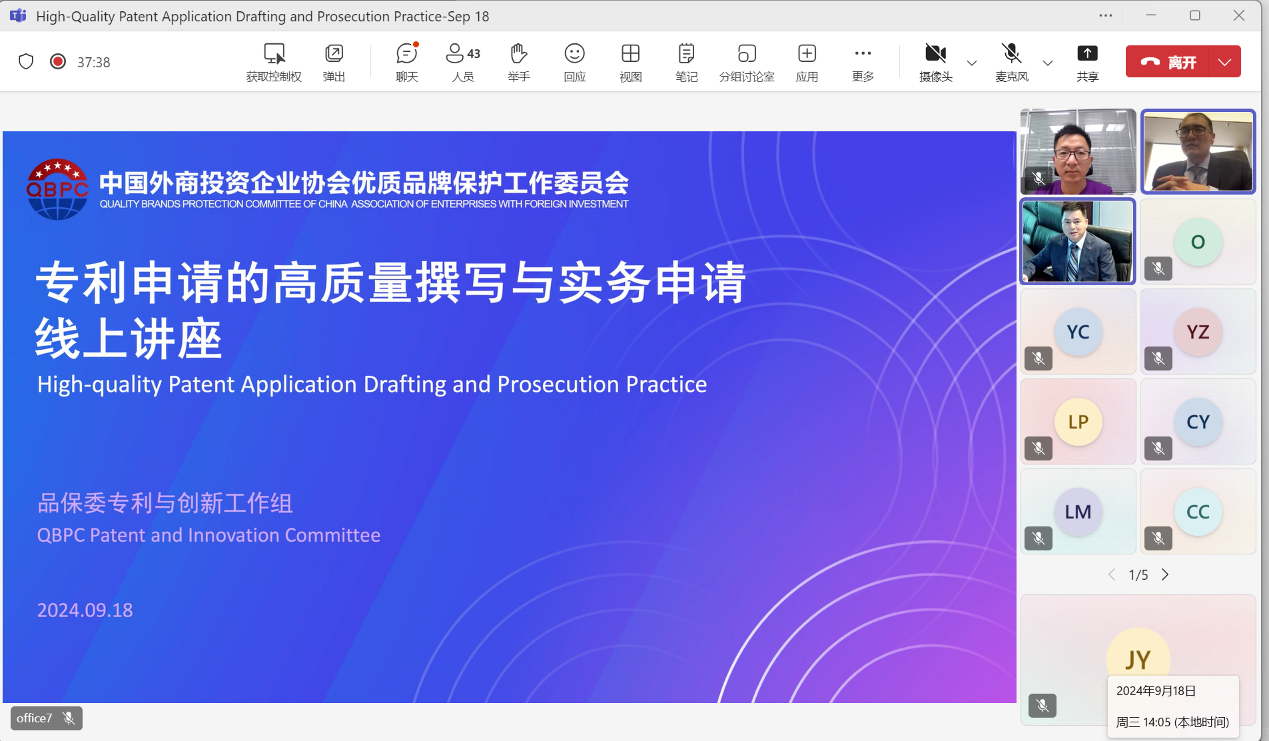On September 18th, the QBPC Patent and Innovation Committee held a seminar on high-quality drafting and practical filing of patent applications. The event was moderated by PIC Vice Chair Simon Xia. The speakers were Yanfeng XIONG, Deputy General Manager of China Patent Agent (Hong Kong) Co., LTD, and Zuoxi TAN, Deputy Director of Shanghai Representative Office of China Patent Agency (Hong Kong) Co., LTD. Over 50 QBPC members attended.

XIONG emphasized that patent drafting was more about the careful layout of legal rights and interests than just the presentation of technical content. He explained in detail the key element of patent infringement—claim interpretation which should be based on the literal meaning, supplemented by the specification as the basis of interpretation. Especially in dealing with functional limitations, environmental features, numerical features, and other complex situations, claim interpretation should strictly follow the specific rules of legal interpretation. In view of the theory and practice of the Judicial Interpretation of Patent Infringement as well as Patent Grant and Confirmation by the Supreme People’s Court, he elaborated on the fundamental principles of patent drafting, such as examining patent documents from the perspectives of grant and confirmation and infringement, as well as targeting at competitors and infringement patterns. He reminded that the title, abstract, technical field, background technology, content of the invention, description of the accompanying drawings, and embodiments should be drafted in accordance with relevant country’s patent laws, as well as the practical requirements from grant and confirmation to infringement, in order to avoid potential limitations and maximize the protection of patent rights and interests. In addition, XIONG shared the tips for drafting functional limiting features which had to be fully disclosed and supplemented by detailed illustrations to ensure the crystal definition of claims. XIONG also highlighted the importance of dependent claims, pointing out their existence as independent entities and relevant drafting strategies.
Focusing on the patent application drafting quality, Tan analyzed the important factors for the success of patent application. He underlined that a high-quality patent application was not only a simple expression of technical contents, but also a combination of legal strategy and technical innovation. TAN used examples to explain the three-step preparation process before patent drafting, four basic requirements for drafting quality, four awarenesses and four keys in claim drafting. He elaborated on how to build a clear and precise technical scheme, precise and accurate claims, and a strong and powerful supporting specification, so that the application could not only meet the examination standards of the Patent Office, but also protect the rights and interests of the innovators effectively and sufficiently. In addition, TAN also gave his unique perspective about creative defense, a critical part in patent examination. He pointed out that creative defense was not only an assessment of technical advancement, but also a vivid manifestation of deep understanding of patent laws and regulations. Through multiple approaches such as comparative analysis, disproof of common knowledge, and skillful application of examination opinions, the creativity of a patent application could be effectively enhanced, thus increasing the possibility of the grant of patent.
In the Q&A session, guest speakers answered the questions raised by the participants, such as the expression of technical effect specification in the US, Europe, and China, the expression of the invention content part in the German case, the strictness of the case examination in recent years and the modification and relaxation of Article 33, and the impact of support and modification of re-examination procedures on the power of examination, etc.
